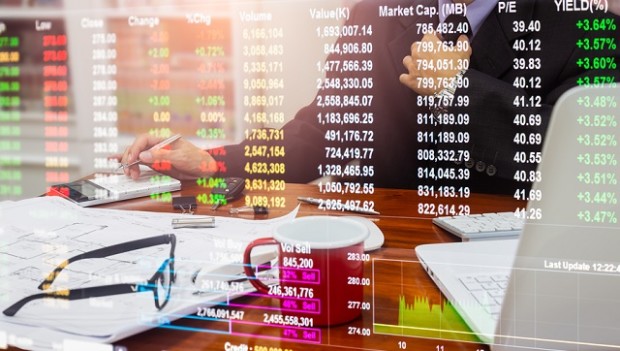

Australia’s stock market seems set to rise after a climb on US and European markets after government and central bank actions to ease the economic pain of the coronavirus outbreak.
The SPI200 futures contract was up 119 points, or 2.47 per cent, at 4944 points at 0800 AEDT on Friday, suggesting a bounce at the open of trading.
David de Garis of NAB’s morning call podcast says some of the optimism is coming from the recent flood of coronavirus management policy announcements and as central banks ease liquidity concerns.
US oil prices surged 35 per cent overnight and the global benchmark Brent also lifted as financial markets assessed the impact of massive central bank stimulus measures.
The local bourse shrugged off an RBA rate cut on Thursday to close in negative territory.
The ASX200 has lost 33.5 per cent in the past four weeks.
The Australian dollar plunged to a low of 55.08 US cents at one point on Thursday, a level last seen in October 2002.
One Aussie dollar was buying 57.43 US cents at 0800 AEDT on Friday up from 56.89 US cents at Thursday’s ASX close.
Yesterday, the Australian and New Zealand currencies have tumble as investors rushed to raise cash amid fears about the coronavirus pandemic’s impact.
Both currencies tumbled to multi-year lows as panic selling swept global markets, overwhelming attempts by central banks to cushion the fallout from the coronavirus.
The Aussie dollar sank 3.5 per cent to $US0.5569 on Thursday and briefly fell as far as $US0.5508, the lowest since late 2002.
It had already dived 3.9 per cent on Wednesday in the largest daily decline in a decade, bringing losses suffered for the week so far to a sickening 9.8 per cent.
The Kiwi dropped 3.5 per cent to $US0.5533, and was quoted as low as $US0.5472, bringing losses for the week to 8.6 per cent.
The Reserve Bank of Australia tried to steady sentiment and stem a rout in government bonds by announcing plans to buy enough debt to keep three-year yields about 0.25 per cent, its first step into quantitative easing.
Three-year bonds duly rallied and yields fell a steep 26 basis points to 0.36 per cent. Yet futures for 10-year bonds still collapsed by more than 50 ticks in the largest daily drop since 1992.
Yields on 10-year cash bonds shot up 44 basis points to 1.61 per cent, the biggest rise since 1996 when the market was far smaller and less liquid than it is now.
Dealers reported huge strains in bond markets as distressed funds sold any liquid asset to cover losses in stocks and redemptions from investors, a tide fuelled in part by automated selling from algorithmic funds.
Such was the speed and scale of the fall in the Aussie that traders suspected the RBA might have to intervene to restore a two-way market, much as it did during the global financial crisis.
“The bond market is dysfunctional,” said Prashant Newnaha, senior Asia-Pacific rates strategist at TD Securities, noting spreads between bids and offers had widened drastically and longer-dated bonds had been swamped by sellers.
“These are not typical bond market moves in a risk-off environment and neither is this dysfunction desired particularly as bond supply is likely to increase, possibly significantly.”
The government has already launched one stimulus package of more than $17 billion to help cushion the economy from the coronavirus, and is expected to announce another soon. All of this spending will be funded by debt.
Local data was utterly overshadowed, which was a shame for Aussie bulls as jobs figures handily beat forecasts with a rise of 26,700 in February.
The jobless rate also fell unexpectedly to 5.1 per cent, although analysts fear it can only rise from here as the coronavirus wreaks havoc in a host of industries.
New Zealand reported the economy grew 0.5 per cent in the December quarter and 1.8 per cent for the year but again analysts assume it will soon be in recession as the virus spreads.

